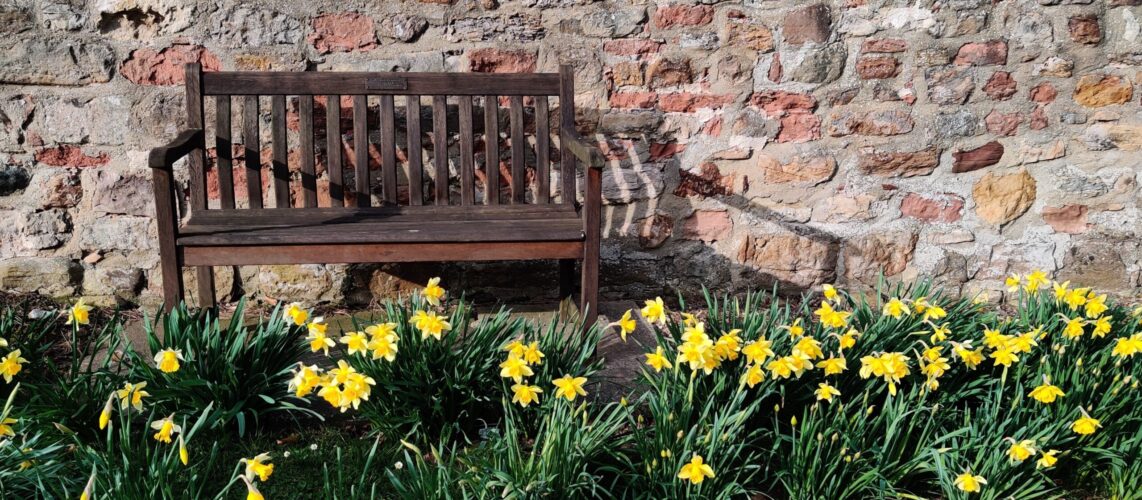CHURCH – DESCRIPTION AND HISTORY

The church of St Mary the Virgin is a modest sandstone building set on a slope close to the centre of the village, in a tranquil churchyard with views east towards the Cleveland Hills. The building is locked most of the time but keys are available from the Church Wardens (Ruth Gibbon – 01325 720109 – and Alice Shaw – 01325 721440). There is a brief description of it in the latest edition of The Buildings of England – Yorkshire: The North Riding, by Jane Grenville and Nikolaus Pevsner. It has also been fully researched, and the details published, by the Church Recording Society.
Details of services are to be found under the Roundabout tab.
The building probably started as a wooden structure and replaced by stone around 1200 when it contained a four bay arcade with round pillars, round chamfered arches with hoodmoulds and early stiff-leaf crockets, and a font. It was thought to be more or less completed by 1300 but then gutted by a Scottish raid when the village was attacked in 1319. Windows were added in the 14th century and it is probable, from architectural evidence, that the low tower was built in the early 16th, there having originally been an open stone bell cote at the western gable end of the nave.
For centuries it was a chapel dependent in the parish of Gilling West, North Yorks and was served by poorly paid curates. They were appointed by a vicar who in his turn was an appointee of the abbey of St Mary’s York until 1540 and who rarely if ever visited Eryholme. The abbey received the great tithes on grain and the curate the petty tithes on livestock, wool and crops. He also had 24 acres of glebe land among the strips in the open fields and received money twice a year at Easter and St Andrew’s Day as well as fees for christenings, marriages and burials.
Eryholme finally became an independent parish in 1887 with the appointment of the Revd. Walter Stewart (1887-1904) as vicar, although he too did not live in Eryholme. Nevertheless he initiated a major restoration and £430 was raised by public subscription because by then the building was in a very sorry state. It was variously described as looking like ‘patched up ruins’ with ‘rude rafters of timber supporting the roof’(Yorkshire Gazette, 21 September 1889, ) high and uncomfortable pews and piles of soil around the outside walls. The restoration work added a new roof, a vestry, two new windows in the south wall to match the 14th century windows, and the floor was lowered by one foot. It was here that charred beams and bones (probably animal) were discovered, with fire marks at the base of the pillars, evidence it is thought of the Scottish raid.
The porch was also rebuilt and a collection of sculptural fragments, which had been found in the churchyard, embedded in the walls, including the ‘Eryholme Madonna’ – see below. Most of the wooden furniture dates from the restoration, including the screen and communion table, as well as the plate. The original box pews were replaced by benches for 80 to 90 people.
In the end, the cost was £839 ( the increase being due to the restoration and replacing of the windows) and the work was completed in 6 months, turning ‘the old barn-like fabric…. Into a very pretty and commodious church’ (Yorkshire Gazette, 21 September 1889). The event was marked by the Bishop of Ripon who preached to a packed congregation, all listening with ‘breathless attention’ and afterwards enjoying tea in the school room.
Stewart was an interesting and popular man who held services every other Sunday with a resulting increase in congregation, so that 43 attended his last service in 1904. He then moved to Gloucestershire but requested to be buried in the churchyard in Eryholme in 1934. In addition he was a noted astronomer, and keen meteorologist and photographer.
The Church has continued to function although congregation sizes have dwindled. Nevertheless there is keen interest in keeping up the fabric and it is still held in great affection by residents, many of whom have relations buried in the churchyard.
FEATURES OF INTEREST
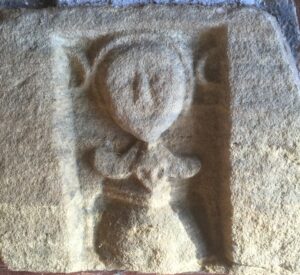
‘Eryholme Madonna’ – embedded in the porch wall, this is much loved but a bit of a mystery. Assumed to be a depiction of the Virgin Mary, the 1966 edition by Pevsner described it as ‘rather like a doll’. Historic England, in its official listing in 1968, described it as an ‘Anglo-Scandinavian figure’, but the Corpus of Anglo-Saxon Stone Sculpture dates it as late medieval or even post medieval. The latest Pevsner states that it may possibly be an expression of the Marian Cult of the Immaculate Heart as the representation of the heart, possibly with outstretched hands, is similar to the cult of Immaculate Heart of the Blessed Virgin Mary. This emerged in the 13th century but has been associated more with Catholic Europe.
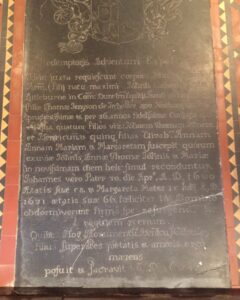
Calverley Monument – situated on the chancel floor. It is made of polished black stone and dedicated to John and Margaret Calverley. Sir John was the first resident Lord of the Manor for three centuries. His grandfather had bought the estate in 1580. It bears the following latin inscription, translated as –
‘They await the coming of the Redeemer.
Side by side lie the bodies of John Calverley Esq., eldest born of John Calverley of Littleburn in the county of Durham, knight, and Margaret (daughter of Thomas Jenyson of Irchester in the area of Northampton, Esq.) a most prudent lady and for 36 years his most faithful wife by whom he begot four sons, viz. John, Thomas, John and Henry, and five daughters Elizabeth, Anne, Anne, Mary and Margaret. Of these remains of John, Anne, Thomas, John and Mary are buried here together until the last day. Their father John on the 30th day of April AD 1660 at the age of 58 and their mother Margaret on 15th July AD 1671 at the age of 66 fell asleep happily in the Lord in the firm hope of rising again to eternal rest.
Henry Calverley the surviving son, grieving, therefore placed and consecrated this monument out of duty and love to them AD 1674.’
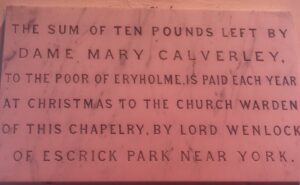
Calverley Charity Plaque – Sir John Calverley’s daughter-in-law, Dame Mary Calverley, established a charity for the poor in the area (now part of Northallerton United Charities) The Wall Plaque states that the sum of ten pounds be paid to the poor each year at Christmas to the Church Warden for distribution. The first record dates from 1795 when 21 people received amounts between £1 6s 0d to 2s.
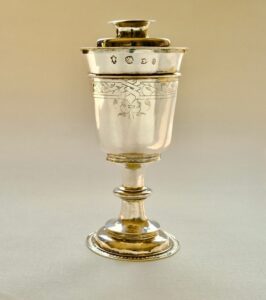
Chalice/communion cup – ( this is not kept in the church). It is made of silver, hallmarked 1570-71 ie post-Reformation, when larger cups were made to allow the whole congregation to take part (before the Reformation, following Catholic practice, only the priest took the bread and wine). It was said to be found in 1900 by Thomas Pickering, the Neasham estate joiner, hidden in the Old Hall cottages and thus thought it was probably hidden away from Cromwell’s men during the Commonwealth. Recent evidence, from a history of the Wrightson family by William Wrightson, disproves this story, as he states he used the cup during communion in and around 1890. It is also not known whether it originally belonged to the church or was donated.
Bells – there are two. The tenor bell, dated c1450, is inscribed with a Greek cross and in Latin, Campana Johannis, the John Bell. It is possible that it was originally hung in the open stone bell cote and is the reason why the lips are worn on both sides where it will have caught the stonework. The treble bell is also in cast iron and dated 1616. It is inscribed with a Greek cross with some decorative motifs and the words ‘Jesus be Our speed’.
Bible , often on the lectern – a King James Revised Version of the Bible, which was presented to the church from ‘Thomasina and her Children’ on September 17 1889. The donor was a friend of the incumbent, Miss Scurfield, and the money apparently came from the sale of the kittens of her cat Thomasina as the inscription shows.
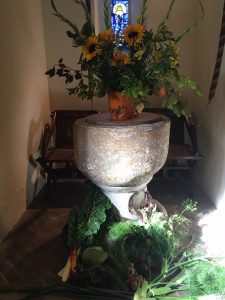
Font – a very plain stone but dating from the early 13th century.
Columns – some of these are covered in flattened rosette shaped plaques, either in relief with red pigmentation or scraped down. Roses are traditionally associated with Mary and these plaques may have been defaced during Edward VI’s reign when appointed commissioners visited churches to enforce the 1547 injunctions and to ban Catholic rites. However, they may either also have been removed by parishioners or during the Commonwealth period when further desecration took place.
Bronze plaque on pulpit (1932) – Pevsner describes this as ‘exquisite’. It depicts the Virgin Mary holding up the infant Jesus with dates of Sir Thomas Wrightson’s birth and death (1839-1921). He was the local landowner and there are several memorials to various members of the family in the church, including the pulpit. The artist is his daughter, Margaret Wrightson FRSBS, a renowned sculptor.
Stained glass windows
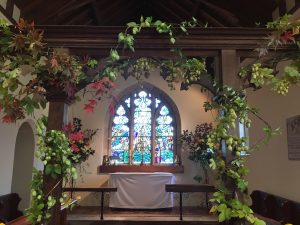
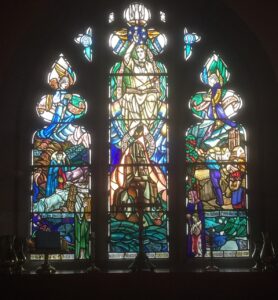
East end – the design is based on the references in the canticle ‘All the works of the Lord’ from the Book of Common Prayer and depicts beasts and cattle on the left hand lancet, Christ Enthroned on the centre lancet and a rural scene on the right hand lancet. It is dedicated to Sir Thomas Wrightson and was designed by Thomas Stachan, an important Scottish stained glass window designer, whose windows are to be found in the Netherlands as well as many churches and cathedrals in the UK.
South Wall – these are two lancets by Donald Strachan and dedicated to Jean Wrightson, wife of Sir Thomas’ son, Sir Guy. They represent Purity and Peace and are inscribed with the words ‘Her ways are ways of pleasantness and all her paths are peace (Proverbs 3:17) and ‘Whatsoever things are lovely think only on these things’ (Philippians 4:8).
East Aisle – this is a modern single lancet with a flowing river, dove and scallop shell design. It was installed in memory of Gwendolin, Lady Wrightson (1883-1964), daughter-in-law of Sir Thomas and designed by Harry Harvey, a Yorkshire stained-glass designer and manufacture, whose windows can be found in eg York and Ripon cathedrals as well as over 70 Yorkshire churches.
Organ – this was built in 1913 by the Positive Organ Company and was assembled by the vicar, the Revd. Douglas Heath in 1950. It was completely restored in 2003 for £7000 as the diocesan organ advisor stated there were very few organs of its type still in existence.
